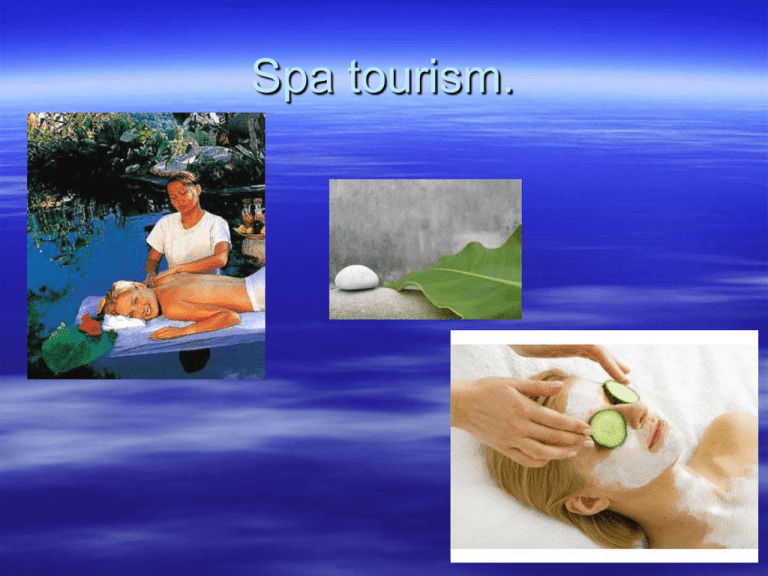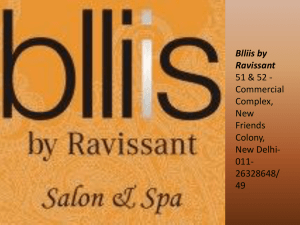Spa tourism. - English for tourism
advertisement

Spa tourism. Contents 1. Definition of tourism and of spa tourism. 2. Insight into the website of the International Spa Association. 3. Definition of the 7 types of spa according to ISPA. 1. Tourism, a definition. Tourism is travel for leisure or business purposes. The World Tourism Organization defines tourists as people who "travel to and stay in places outside their usual environment for more than 24 hours and not more than one consecutive year for leisure, business and other purposes not related to the exercise of an activity remunerated from within the place visited." Is spa tourism part of medical tourism? Spas are defined as destinations people visit for renewal of body, mind and spirit. Medical tourism is the practice of people traveling across borders for medical treatment. Is spa tourism part of medical tourism? The main strength of spas is providing relaxation and de-stressing, as well as preventative health. They are destinations where people in fundamentally good health focus on getting healthier. How do you get healthier? fitness, How do you get healthier? nutrition, body therapies and beauty treatments, sleep, How do you get healthier? mind-body modalities, etc. Criteria to determine whether an activity is mind-body It includes a perception of movement There is a focus on breathing and breath sounds Attention is paid to anatomical alignment. The activity has a quality of being « energycentric (chi or prana). Is spa tourism part of medical tourism? The spa environment is designed to address and soothe (apaiser) all five senses – that is why you will often find soft music, beautiful lighting, relaxing aromas, subtle flavors and a healing touch. Every element is dedicated to facilitate physical, emotional and spiritual rejuvenation. Is spa tourism part of medical tourism? Spa staff usually have expertise in areas like massage therapy, beauty services, fitness training, hotel management or spa management, and some are practioners in yoga, acupuncture or ayurveda, But licensed medical doctors are not routinely part of the equation. Wellness and health tourism 2. The International Spa Association: http://www.experienceispa.com/ Provide useful information and a job bank. The US Spa industry US spa industry 3. There are 7 types of spas (according to ISPA) 1. CLUB SPA A facility whose primary purpose is fitness on a day-use basis. Types of spa. 2. DAY SPA A spa offering a variety of spa services on a day-use basis. Day spas offer many of the same services and procedures as cosmetic spas. Types of spa. 3. CRUISE SHIP SPA A spa aboard a cruise ship. Types of spa. 4. DESTINATION SPA A destination spa is a facility with the primary purpose of guiding individual spa-goers to develop healthy habits. 4. Destination spa. Historically it is a sevenday stay. This lifestyle transformation can be accomplished by providing a comprehensive program that includes spa services, physical fitness activities, wellness education, healthful cuisine etc. Types of spa. 5. MEDICAL SPA A facility that operates under the full-time, on-site supervision of a licensed health care professional The primary purpose is to provide comprehensive medical care in an environment that integrates spa services. Types of spa. 6. MINERAL SPRINGS SPA A spa offering an on-site source of natural mineral, thermal or seawater used in hydrotherapy treatments. Types of spa. 7. RESORT/HOTEL SPA A spa owned by and located within a resort or hotel providing spa services, fitness and spa cuisine menu choices. 7. resort / hotel spa. In addition to the leisure guest, this is a great place for who wish to take advantage of the spa experience while away from home. In many cases resort/hotel spas also for local clientele and may offer for people that live in the community.








